仁爱版七年级英语上册:Unit 1 Topic 1. Welcome to China! Section A 课件(共33张PPT)
文档属性
| 名称 | 仁爱版七年级英语上册:Unit 1 Topic 1. Welcome to China! Section A 课件(共33张PPT) |  | |
| 格式 | zip | ||
| 文件大小 | 7.1MB | ||
| 资源类型 | 教案 | ||
| 版本资源 | 仁爱科普版 | ||
| 科目 | 英语 | ||
| 更新时间 | 2019-11-21 13:24:36 | ||
图片预览

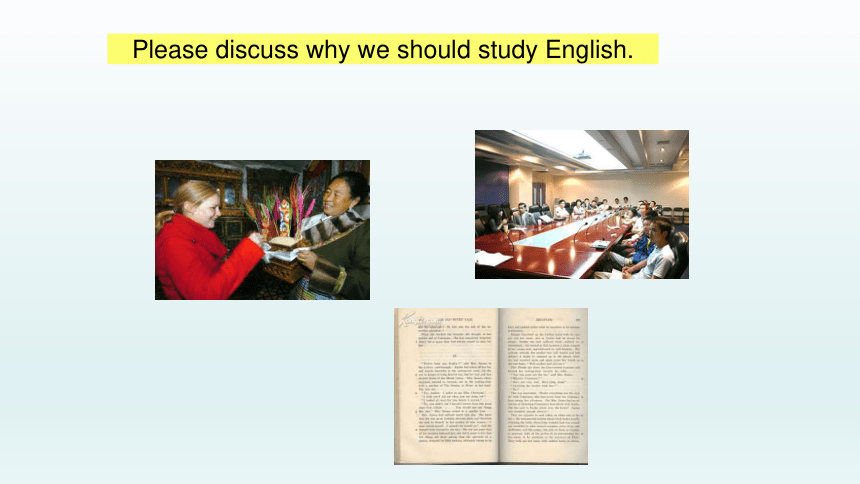
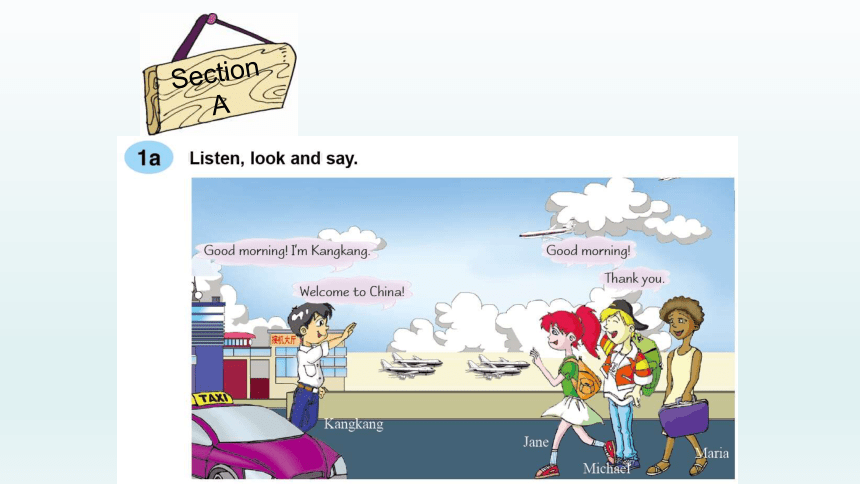
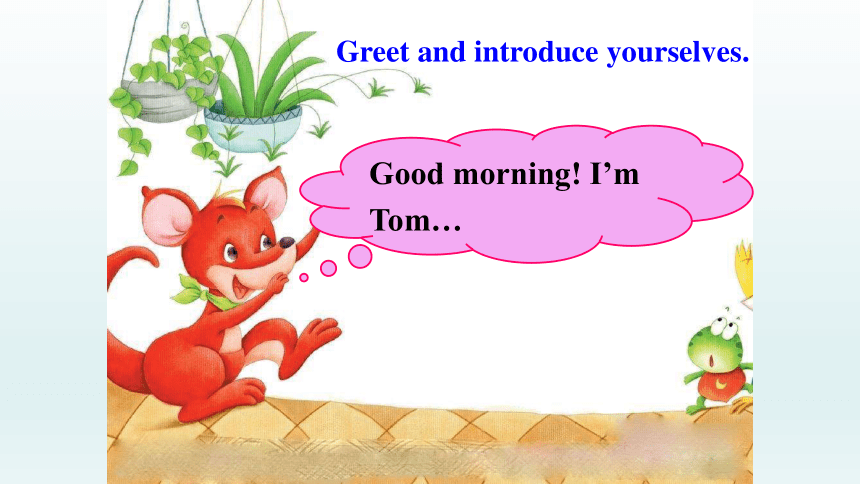
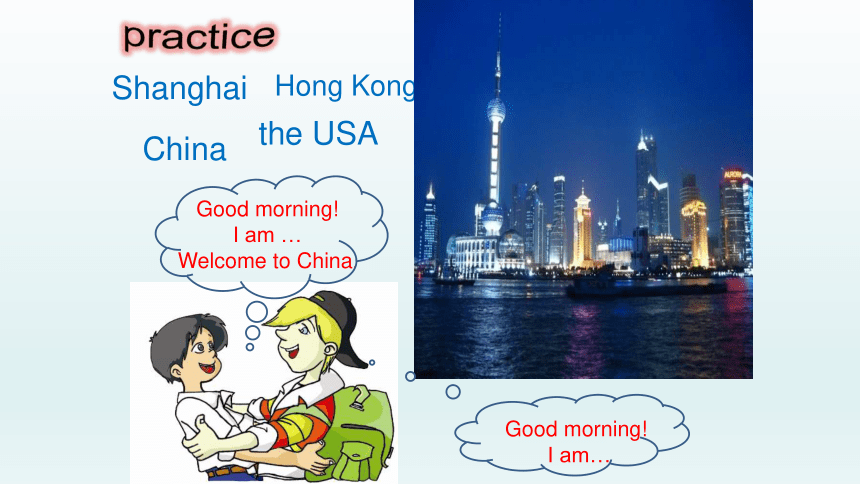
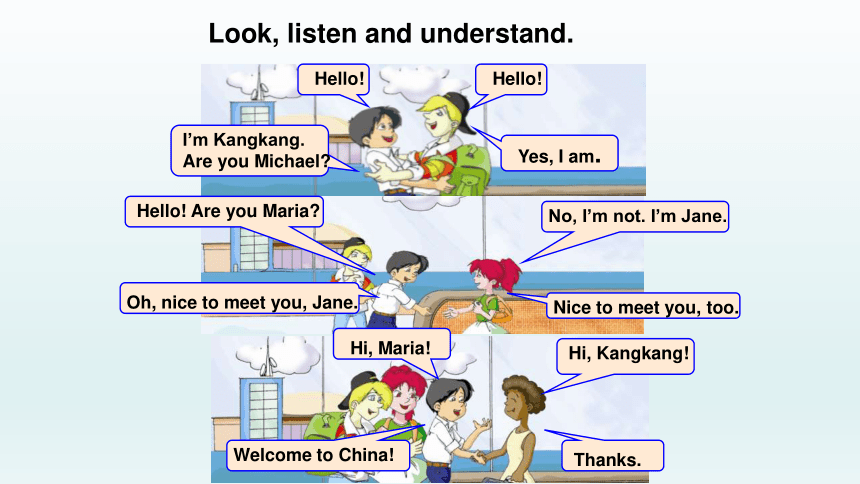

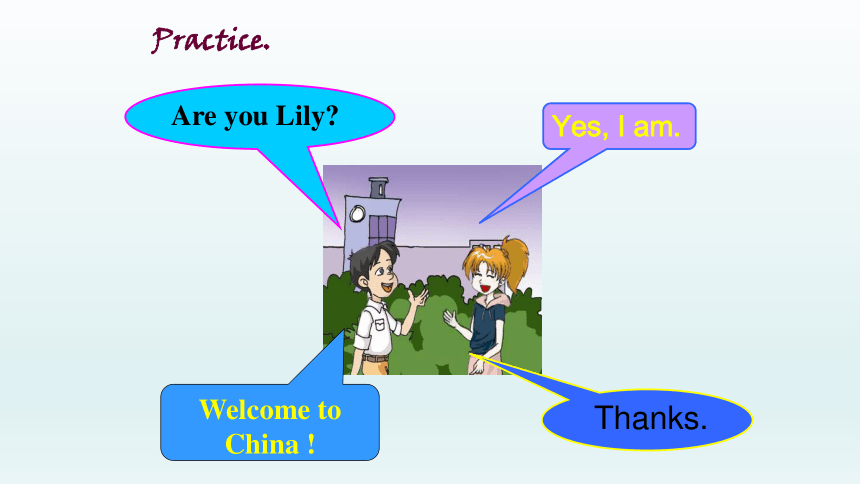


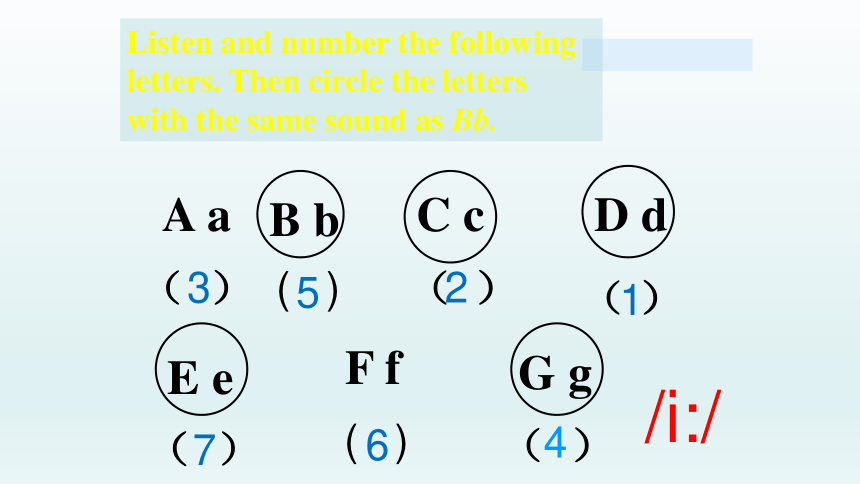
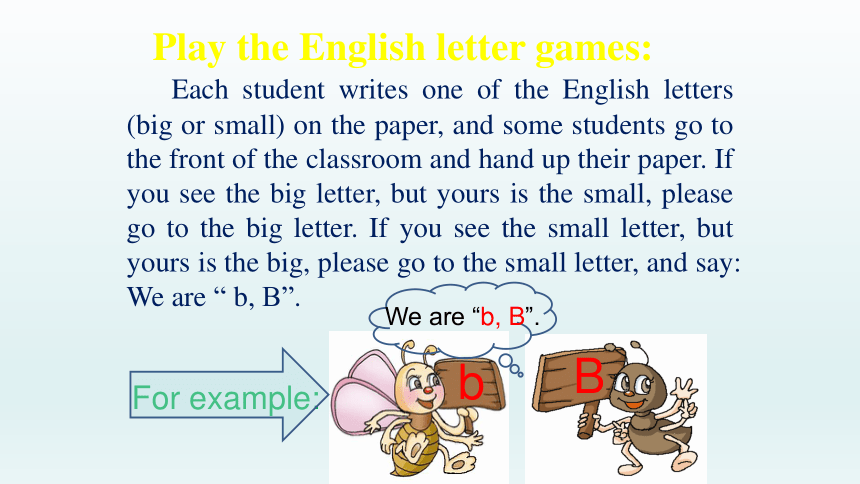
文档简介
课件33张PPT。Unit 1 Making New FriendsPlease discuss why we should study English.Section
AKangkangMichaelJaneMariaGood morning! I’m Tom…Greet and introduce yourselves.the USAChina Hong KongShanghai Good morning!
I am…Good morning!
I am …
Welcome to China.Look, listen and understand.Hello!I’m Kangkang.
Are you Michael?Hello!Hello! Are you Maria?No, I’m not. I’m Jane.Nice to meet you, too.Oh, nice to meet you, Jane.Welcome to China!Thanks.Yes, I am.Hi, Maria!Hi, Kangkang!Notice当别人问你“Are you …?”时,否定回答应为:
No, I am not. I am ... / No. I am ...。
注:不能只回答No, I am not. 英语中,这样的回答会被认为是不礼貌的行为。Nice to see you. 答语通常为Nice to see you, too.
这样的问候常在以下两种情景中使用:
1.双方初次见面经人介绍后互相问候。
2.熟悉的人好久不见,偶然相逢时表达双方见面后的
高兴心情。Are you Lily?Yes, I am. Thanks.Welcome to China !Practice.Hello! ________! Practice.HelloNice to see you, Yingying.Nice to see you, too,
Huanhuan.________________________________________Listen, say and trace.A a B b D d E e F f G g Listen and number the following letters. Then circle the letters with the same sound as Bb.C c( )( )( )( )( ) ( )/i:/12 37( )
4 5 6Play the English letter games: Each student writes one of the English letters (big or small) on the paper, and some students go to the front of the classroom and hand up their paper. If you see the big letter, but yours is the small, please go to the big letter. If you see the small letter, but yours is the big, please go to the small letter, and say: We are “ b, B”.
bBFor example:wWe are “b, B”.Play the English letter games:① The first student in the first team says “A” quickly, the second student follows with “B”,and the other students follow with “C,D,E,F,G,A,B ...” one by one.Welcome to China !
— Good morning!???????????
— Good morning! I’m Kangkang.
Hello! / Hi!
— Are you Maria?
— Yes, I am. / No, I’m not. I’m Jane.
—Nice to meet you.
— Nice to meet you, too.
Thanks.Sum upSection B Unit 1 Making New Friends T: Good morning.??????
?S: Good morning.
T: I’m ..., are you ...???
S: Yes, I am.
T: Nice to see you.
S: Nice to see you, too.1a Look, listen and say. This is Michael.This is Maria.This is… This is…句型通常在两种情境中使用:
1.向别人介绍第三方时;
2.用来介绍、说明某种事物。This is my teacher, Mr. Brown…这是……How do you do?
Nice to see you..???Listen to the conversations
and number the pictures.123Listen again and choose. A: Mr. Brown, this is my mom.
Mom, _____ my teacher,
Mr. Brown.
B: How do you do?
A:_____________?Nice to see you
This is
How do you doBCListen again and fill in the blanks. A: Lily, ________my teacher,
Miss Wang.
B: ________________,
Miss Wang.
A: Nice to meet you, too.this is Nice to meet youListen again and fill in the blanks. A: Jane, this is my dad.
Dad, ________Jane.
B: Nice to meet you.
A: ________________.
this is Nice to meet you, tooT: Hello, Maria. This is …T: …, this is …S1: How do you do?S2: How do you do?
(shake hands 握手)How do you do?How do you do?How do you do?该句为正式场合首次见面时的问候语。通常回答也用:How do you do ?Nice to see/meet you.通常用于双方初次见面经介绍相识之后的场合,是一种礼貌用语。回答时常用Nice to see /meet you, too.Work in groups. Read 1a and act out the conversations. Then make up new ones with the words in the box. This is my teacher,
Miss Wang.
A: How do you do?
B: How do you do?practiceThis is my dad.Mr. +姓Miss +姓Mrs.+姓
Ms. +姓 英语国家常把男士称Mr., 女士称为Miss(未婚)或Mrs.(已婚)。如果在不明女士是否已婚的情况下, 可用Ms.(这是英国女权运动的产物)。
需要注意的是: Mr.或Ms.通常与姓名或姓连用, 而不能单独与名连用; Miss可单独用来称呼女性;Mrs.只能与夫姓或自己的姓加夫姓连用。 Mr. Brown: Hi , Miss Wang! _____________
Miss Wang: _____ , Mr. Brown! Nice to see
you, too.
Mr. Brown: Miss Wang, this is Ms. Jones.
Ms. Jones, ________________
Miss Wang: How do you do?
Ms. Jones: ________________
Complete the conversation and then practice with your partner.Nice to see you.
this is Miss Wang.How do you do ?Hi
D. Nice to meet you, too.4. Are you Miss Wang? 5. Good Morning!E. Yes, I am.1. How do you do?B. How do you do?3. Nice to meet you.C. Thank you.Read and match.2. Welcome to Beijing!A. Good Morning!Listen, say and trace. A a G g H h Mm F f
L l J j N n I i K kListen and number the following letters. Then circle the letters with the same sound as Aa.( )( )( )( )( )( )( )( )( )( )123456789 10
AKangkangMichaelJaneMariaGood morning! I’m Tom…Greet and introduce yourselves.the USAChina Hong KongShanghai Good morning!
I am…Good morning!
I am …
Welcome to China.Look, listen and understand.Hello!I’m Kangkang.
Are you Michael?Hello!Hello! Are you Maria?No, I’m not. I’m Jane.Nice to meet you, too.Oh, nice to meet you, Jane.Welcome to China!Thanks.Yes, I am.Hi, Maria!Hi, Kangkang!Notice当别人问你“Are you …?”时,否定回答应为:
No, I am not. I am ... / No. I am ...。
注:不能只回答No, I am not. 英语中,这样的回答会被认为是不礼貌的行为。Nice to see you. 答语通常为Nice to see you, too.
这样的问候常在以下两种情景中使用:
1.双方初次见面经人介绍后互相问候。
2.熟悉的人好久不见,偶然相逢时表达双方见面后的
高兴心情。Are you Lily?Yes, I am. Thanks.Welcome to China !Practice.Hello! ________! Practice.HelloNice to see you, Yingying.Nice to see you, too,
Huanhuan.________________________________________Listen, say and trace.A a B b D d E e F f G g Listen and number the following letters. Then circle the letters with the same sound as Bb.C c( )( )( )( )( ) ( )/i:/12 37( )
4 5 6Play the English letter games: Each student writes one of the English letters (big or small) on the paper, and some students go to the front of the classroom and hand up their paper. If you see the big letter, but yours is the small, please go to the big letter. If you see the small letter, but yours is the big, please go to the small letter, and say: We are “ b, B”.
bBFor example:wWe are “b, B”.Play the English letter games:① The first student in the first team says “A” quickly, the second student follows with “B”,and the other students follow with “C,D,E,F,G,A,B ...” one by one.Welcome to China !
— Good morning!???????????
— Good morning! I’m Kangkang.
Hello! / Hi!
— Are you Maria?
— Yes, I am. / No, I’m not. I’m Jane.
—Nice to meet you.
— Nice to meet you, too.
Thanks.Sum upSection B Unit 1 Making New Friends T: Good morning.??????
?S: Good morning.
T: I’m ..., are you ...???
S: Yes, I am.
T: Nice to see you.
S: Nice to see you, too.1a Look, listen and say. This is Michael.This is Maria.This is… This is…句型通常在两种情境中使用:
1.向别人介绍第三方时;
2.用来介绍、说明某种事物。This is my teacher, Mr. Brown…这是……How do you do?
Nice to see you..???Listen to the conversations
and number the pictures.123Listen again and choose. A: Mr. Brown, this is my mom.
Mom, _____ my teacher,
Mr. Brown.
B: How do you do?
A:_____________?Nice to see you
This is
How do you doBCListen again and fill in the blanks. A: Lily, ________my teacher,
Miss Wang.
B: ________________,
Miss Wang.
A: Nice to meet you, too.this is Nice to meet youListen again and fill in the blanks. A: Jane, this is my dad.
Dad, ________Jane.
B: Nice to meet you.
A: ________________.
this is Nice to meet you, tooT: Hello, Maria. This is …T: …, this is …S1: How do you do?S2: How do you do?
(shake hands 握手)How do you do?How do you do?How do you do?该句为正式场合首次见面时的问候语。通常回答也用:How do you do ?Nice to see/meet you.通常用于双方初次见面经介绍相识之后的场合,是一种礼貌用语。回答时常用Nice to see /meet you, too.Work in groups. Read 1a and act out the conversations. Then make up new ones with the words in the box. This is my teacher,
Miss Wang.
A: How do you do?
B: How do you do?practiceThis is my dad.Mr. +姓Miss +姓Mrs.+姓
Ms. +姓 英语国家常把男士称Mr., 女士称为Miss(未婚)或Mrs.(已婚)。如果在不明女士是否已婚的情况下, 可用Ms.(这是英国女权运动的产物)。
需要注意的是: Mr.或Ms.通常与姓名或姓连用, 而不能单独与名连用; Miss可单独用来称呼女性;Mrs.只能与夫姓或自己的姓加夫姓连用。 Mr. Brown: Hi , Miss Wang! _____________
Miss Wang: _____ , Mr. Brown! Nice to see
you, too.
Mr. Brown: Miss Wang, this is Ms. Jones.
Ms. Jones, ________________
Miss Wang: How do you do?
Ms. Jones: ________________
Complete the conversation and then practice with your partner.Nice to see you.
this is Miss Wang.How do you do ?Hi
D. Nice to meet you, too.4. Are you Miss Wang? 5. Good Morning!E. Yes, I am.1. How do you do?B. How do you do?3. Nice to meet you.C. Thank you.Read and match.2. Welcome to Beijing!A. Good Morning!Listen, say and trace. A a G g H h Mm F f
L l J j N n I i K kListen and number the following letters. Then circle the letters with the same sound as Aa.( )( )( )( )( )( )( )( )( )( )123456789 10
同课章节目录
- Unit 1 Making new friends
- Topic 1 Welcome to China!
- Topic 2 Where are you from?
- Topic 3 How old are you?
- Unit 2 Looking different
- Topic 1 I have a small nose
- Topic 2 What does she look like?
- Topic 3 Whose jacket is this?
- Unit 3 Getting togethe
- Topic 1 Does he speak Chinese?
- Topic 2 What do your parents do?
- Topic 3 What would you like to drink?
- Unit 4 Having fun
- Topic 1 What can I do for you?
- Topic 2 Would you like to cook with us?
- Topic 3 What time is it now?
